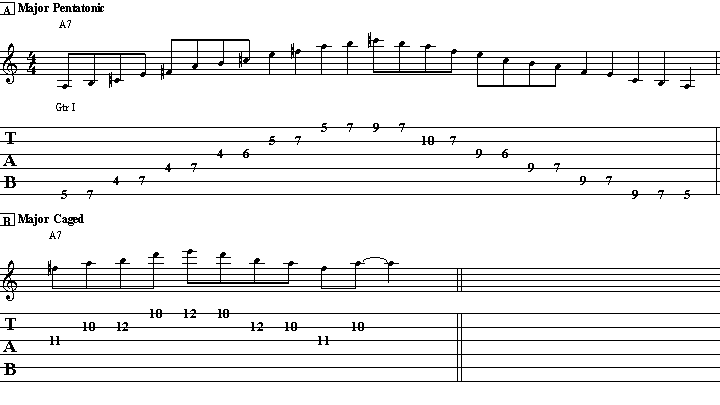Major Blues Caged Guitar Lesson
In this video, Matthew Charles Heulitt will show you how to play the major blues caged for soloing in the style of B.B. King from his “The Complete Guitarist” guitar course.
So we’re going to take that same concept on major scale soloing and apply it we’re going to keep the same key and we’re going to take sort of more of a major approach and um you know we’re jamming on an 7th chord it’s dominant so and the cool thing the thing that makes it bluesy is that it goes both ways it goes major it goes minor.
So and this this sort of kind of classic B.B. king stuff we’re definitely going to get into how to just like rip this thing apart but you know in order to get to that level you want to be able to make music and and really know where you are in the phrase because you know there’s a lot of people that can flap their fingers all over the place but if you don’t know where one is you don’t know where your root is it’s really just kind of saying nothing.
So let me let me talk a little bit about so before we were on the root with our third finger now we’re going to come to it with our first finger so we’re staying in a and it’s actually a really similar box five note box okay but everything all the rules sort of change about which notes you can bend and which notes you can’t so the root is still not bendable don’t mess with that thing okay you can you can inflict it you can slide into it um and the same thing with the note below that you just kind of use that note to step into it.
But this one this one you can do with a half step whole step thing. okay and that’s definitely an ear thing to be able to feel between where those are and i’m kind of going floating in between both of them okay uh and then so then the next note is this guy this is really just a passing tone you don’t want to hang out there so i’m always coming back to the root but you know there’s certain notes you want to sit on in certain ones you don’t and there’s kind of if you know some of these basic rules about it.
You can really get to making good music okay and then the last one this note which is an e it’s the fifth you can bend it a whole step i recommend it uh a minor third which is a step and a half so that’s going all the way from so your options here are a whole step and minor third now not all guitars that you’re going to be able to do that on kind of some some a lot of guitars will fret out at that point so so it may be your fault or maybe your fault if you’re not making it, there you go broken string.
Alright so i’m going to show you with a new guitar with my 335, one of my favorite things and i’m gonna show you again this sort of major version major box. So it ends up sounding pretty but it’s a really great place to start and kind of take yourself back even you know if you’ve already sorted that stuff out maybe you didn’t realize that oh it’s all about the root and like which notes that you can bend so uh that’s just a really great thing to explore.
And what i’m gonna show you too is that you can you can kind of float in between those two things and get this sort of clapton hendrix bb king sort of vibe um just by floating back and forth and and following these rules again trying to be aware of the root and the one and where all that stuff happens, so yeah so i was kind of exploring just these little two note patterns right and it’s just again we just have these little five note boxes so once you get kind of comfortable playing the roots then you can start to explore some of the little things that you can do around that and so there’s also scales obviously we haven’t even talked about that.
But let me show you a little bit about that so i’m sort of expanding so it’s like now now i’ve got six notes in each position so here’s the minor version and then the major version and i’m picking everything or you can use legato right so don’t try to move too fast because we want to keep things in time still so i might do something like that with a metronome and work on it with quarter notes eighth notes triplets and just kind of work it slowly so you get to a point where you’re warmed up and you feel like you can go but again this is sort of like the frosting on top you want to be able to find that root you want to know where you’re at and be able to play hop between major and minor.

🎸 Check out the entire “The Complete Guitarist” guitar program. https://www.guitarcontrol.net/thecompleteguitarist/



